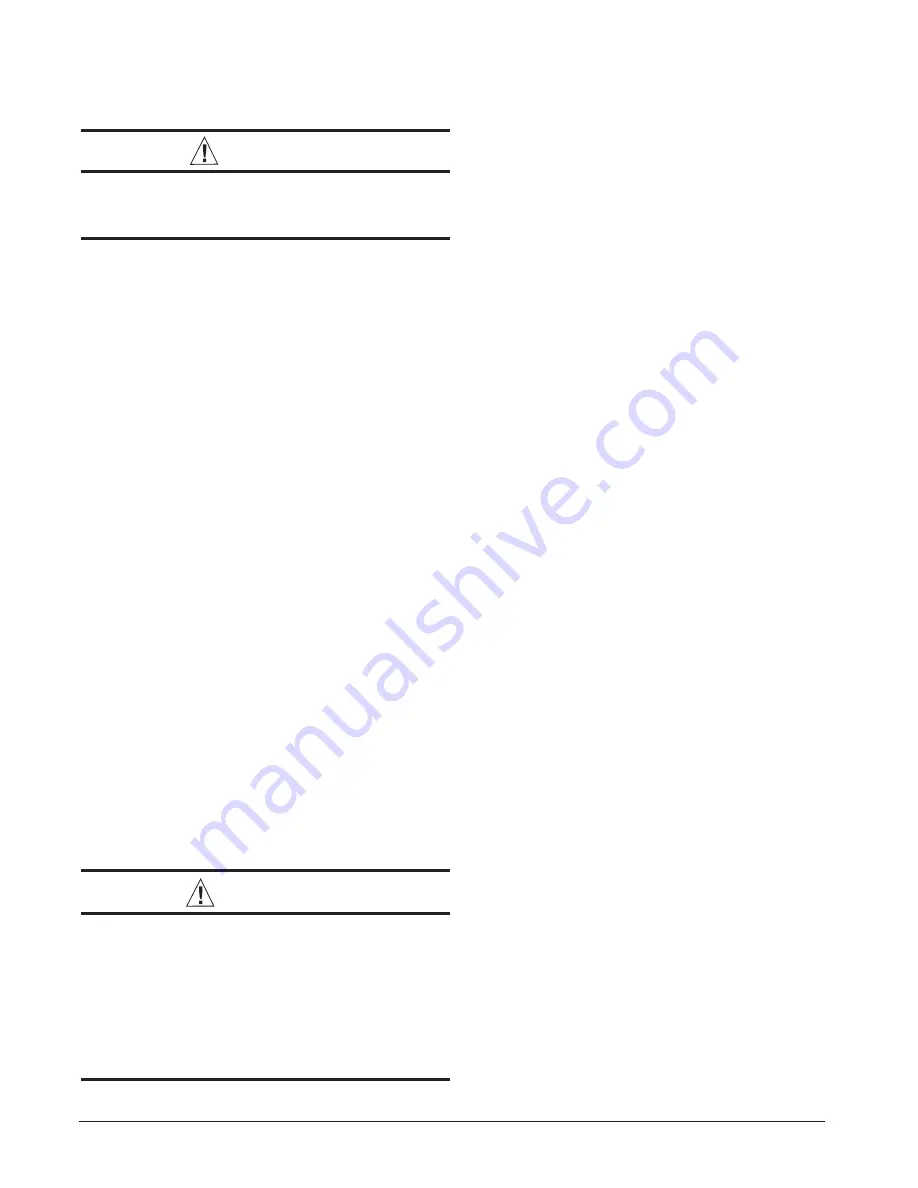
23
3. Remove the burner door from the furnace.
4. Turn the gas control switch to the OFF position.
CAUTION:
Label all wires prior to disconnection when
servicing controls. Wiring errors can cause
improper and dangerous operation.
5. Disconnect the wires from the gas valve, igniter, fl ame
sensor, and fl ame rollout switch.
6. Using two wrenches, separate the ground-joint union
in the gas supply piping at the furnace.
8. Remove all screws securing the Manifold Assembly
to the Burner Box.
9. Carefully remove the Burner Assembly from the
furnace.
DO NOT DAMAGE THE IGNITER WHILE
REMOVING THE BURNER ASSEMBLY.
10. Inspect the burners for accumulated dust or debris.
If necessary carefully clean them with a soft wire
brush and a vacuum cleaner.
DO NOT DAMAGE THE
IGNITER WHILE CLEANING THE BURNER.
11. Replace all the parts in reverse order that they were
removed.
12. Follow the lighting instructions found on the furnace
door to return the furnace to operation. Verify proper
operation after servicing.
Blower Compartment
Dirt and lint can create excessive loads on the motor
resulting in higher than normal operating temperatures
and shortened service life. It is recommended that the
blower compartment be cleaned of dirt or lint that may
have accumulated in the compartment or on the blower
and motor as part of the annual inspection.
Heat Exchanger and Burner Maintenance
The furnace should operate for many years without
soot buildup in the fl ue passageways, however, the fl ue
passageways, the vent system, and the burners should be
inspected and cleaned (if required) by a qualifi ed service
technician annually to ensure continued safe operation.
Particular attention must be given to identify deterioration
from corrosion or other sources.
WARNING:
Holes in the vent pipe or heat exchanger can
cause combustion products to enter the home.
Replace the vent pipe or heat exchanger if leaks
are found. Failure to prevent the circulation
of combustion products into the living space
can create potentially hazardous conditions
including carbon monoxide poisoning that
could result in personal injury or death.
Lubrication
DESCRIPTION OF COMPONENTS
The descriptions below are various functional components
that affect the operation and shutting down of the furnace.
Some of these components and their locations are shown
in Figure 31.
If any component of the furnace must be
replaced, use only factory authorized replacement parts
specifi ed in the Replacement Parts List provided online.
Blower Limit Switch
The Blower switch prevents furnace operation when blower
is not operational.
Condensate Drain Switch
The Condensate Drain Switch will shut down the furnace
if the condensate drain from the collector pan becomes
blocked.
Flame Roll-Out Switch
The fl ame roll-out switch verifi es that the burner fl ames
are drawn into the heat exchanger tubes. If the burner
fl ames are not properly drawn into the heat exchanger, the
fl ame roll-out switch will close the gas valve and initiate
the shutdown cycle.
Flame Sensor
The fl ame sensor verifi es when a fl ame has carried over
from the igniter to the opposite end burner. If no fl ame is
detected, the furnace will shut down within 4 seconds.
Gas Valve
The gas valve controls the fl ow of gas to the burners.
When the gas valve is energized it automatically opens
and regulates the gas pressure in the manifold.
Inducer Assembly
The inducer assembly vents products of combustion to
the outside
.
Pressure Switch
The pressure switch verifi es that the inducer is drawing
the combustion gases through the heat exchanger. If
the fl ame is not properly drawn into the heat exchanger
tube, the rollout switch or the fl ame sensor will shut the
furnace down.
Supply Air Limit Switch
The supply air limit switch prevents the air temperature
leaving the furnace from exceeding the maximum
allowable outlet air temperature
The bearings in the blower motor and inducer blower used
in these furnaces are pre-lubricated and sealed by the
manufacturer. No further oiling of the bearings is required
for the life of the motor.
Vent System
Check the inlet pipe (if applicable) and outlet pipe to ensure
they are not blocked by debris. Any damaged section of vent
pipe must be replaced, and any obstruction or blockage
must be removed prior to operating the furnace.














































